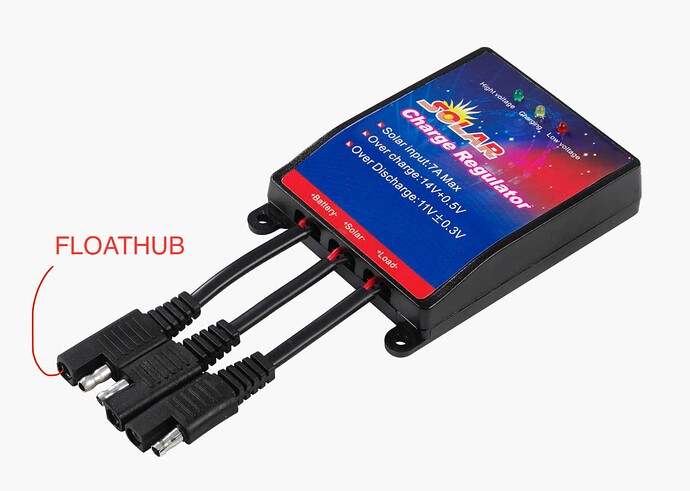Loving my Floathub so far. But I am not sure I have my solar panel charger or starter battery (battery onw) hooked up correctly. See my chart over time:
I would expect my starter battery (battery one) to be almost flat all the time, independent of the solar panel. Now that I am writing this: maybe it’s not a floathub connection thing, but more the way I have wired my batteries and solar together
But just to make sure: is the marked spot on the charger (see photo below) where I need to get the solar panel charger hooked from?
It depends a little bit on what you want to measure. If you attach a FloatHub voltage sense line to the output of a charge controller (i.e. the same connection that leads to the battery), then it will essentially record the battery’s voltage. If you connect it to the input side (middle connection on your picture), it will monitor voltage from the panel. This can be very useful to show which days are sunny, which are not, and how much potential solar voltage is available for battery charging.
And note that that your battery one voltage is actually quite stable (between 13.6 and 13.9 volts). On a larger y scale, it looks like this:
Excellent thanks for the reply. So for my use, I do want to change the connection to the middle wire on the controller.
Zooming out on the graph was smart: thanks. 
Sure thing. Let us know if you have any other questions or comments.
I have another question now.  - I have wired it up as instructed and my solar charger is connected to the house bank. See image of graph below. The spikes seem to be when I have been running the engine and the alternator has been providing power. Is it normal that the solar also rises together with the alternator?
- I have wired it up as instructed and my solar charger is connected to the house bank. See image of graph below. The spikes seem to be when I have been running the engine and the alternator has been providing power. Is it normal that the solar also rises together with the alternator?
Note: I haven’t hooked up Floathub to the alternator yet.
The answer is, “it depends”. Generally an alternator is tied into your battery bank. Given the above graph, it seems probable that your solar charge controller is not isolating the solar connection from the battery connection, so that if the battery connection has higher voltage than the connection to the solar panel, that voltage feeds to the panel connection.
You can isolate that voltage using a diode. A diode only lets voltage flow “one way”, so it would let power from the solar panel into the charge controller, but prevent power from the charge controller flowing out to the solar panel. This would isolate the panel voltage and let the FloatHub see the panel voltage independent of other voltages supplied to the charge controller.
Having said that, your solar panels almost certainly already has a diode in place, but it would be be physically inside the panel somewhere, usually where the feed wires come from on the bottom of the panel. If you get a FloatHub sensing line on the other side of that diode, then you would be able to monitor panel voltage isolated from the controller. Accessing that connection may not be easy, however.
Ah, that makes perfect sense. I looked at the insides of the charger, and as you stated: looks gnarly and not really easy to interface with. I will try and place a diode where you suggest.
Just a follow up. I installed a diode as you suggested and now it looks like I would have expected. See attached image (diode installed Aug 16). Thanks for the help.
Thanks for the feedback, always appreciated. Pretty easy to tell when the diode went in place 





